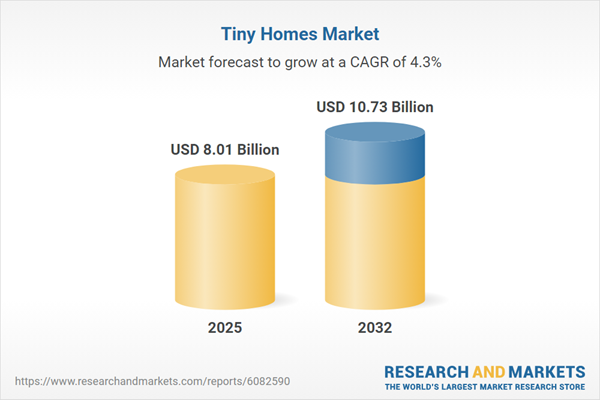Speak directly to the analyst to clarify any post sales queries you may have.
The tiny homes market is rapidly redefining how businesses, developers, and policymakers approach residential solutions, propelled by shifts in consumer preferences and innovations in construction technology.
Market Snapshot: Tiny Homes Market Overview
The tiny homes market grew from USD 7.68 billion in 2024 to USD 8.01 billion in 2025. It is expected to continue growing at a CAGR of 4.25%, reaching USD 10.73 billion by 2032. This steady expansion is driven by rising demand for affordable, sustainable, and flexible housing options, as well as increased interest from governments, developers, and consumers seeking efficient, cost-effective spaces.
Tiny Homes Market Scope & Segmentation
This report delivers detailed analysis and forecasts across core segmentation areas, offering strategic clarity for senior decision-makers evaluating investment, procurement, and market entry.
- Construction Types: On site built solutions, prefabricated units (including modular and panelized systems).
- Modular Systems: Multi module and single module configurations for scalable or standalone applications.
- Panelized Solutions: Customizable designs emphasizing fast assembly and design flexibility.
- Applications: Commercial office and retail units, hospitality (bed and breakfasts, hotels), residential primary and secondary homes, vacation rentals for both long and short-term stays.
- End Users: Government and institutions (including disaster relief, military housing), individual consumers, real estate developers, rental operators for various lease durations.
- Sizes: Footprints under 400 square feet, 400 to 600 square feet, and above 600 square feet for premium and smart home markets.
- Material Choices: Composite, concrete, steel (heavy and light gauge), and wood (structural insulated panels, timber frame).
- Regional Coverage: Americas (North America, Latin America), Europe, Middle East & Africa, and Asia-Pacific, highlighting country-level opportunities and regulatory trends.
Tiny Homes Market: Key Takeaways for Strategic Leadership
- Technological advancements in modular and panelized construction methods enable faster project delivery and greater design flexibility.
- Growing adoption among diverse end users, including public sector, real estate, and rental service providers, is driving market penetration beyond traditional consumer channels.
- Segment diversification supports commercial, hospitality, and residential innovation, allowing tailored solutions for micro-communities, pop-up retail, and tourism providers.
- Materials science is broadening construction options, with steel, concrete, and advanced composites providing alternatives to traditional timber and wood systems.
- Regional policy incentives and urban density shifts vary significantly by geography, requiring customized strategies for supply chain localization and manufacturing footprints.
- Sustainability and circular economy considerations play a growing role in design and regulatory decisions, shaping competitive positioning and customer appeal.
Tariff Impact and Supply Chain Adaptation
A recent tariff regime has introduced challenges for international supply chains, particularly for steel, concrete, and composite materials sourced from Asia-Pacific. This has accelerated the shift toward localized production in the Americas and Europe and prompted manufacturers to form new alliances, optimize modular designs, and streamline material logistics. These supply chain changes impact project budgeting and end-user pricing, but also drive efficiencies through automation and digital fabrication integration.
Methodology & Data Sources
This report utilizes a robust, mixed-methods research approach combining primary interviews with industry executives, quantitative surveys, field observations from production facilities, and comprehensive secondary analysis from government and trade sources. All findings are peer-reviewed to ensure reliability and actionable insights.
Why This Report Matters
- Enables C-level executives and strategy leaders to understand technology disruption, policy impacts, and segment diversification in the tiny homes market.
- Supports procurement and investment decisions by revealing trends in materials, construction, and application-driven demand across core global regions.
- Equips organizations to navigate complex supply chain challenges, evolving regulations, and sustainability imperatives for long-term growth and differentiation.
Conclusion
The tiny homes market is evolving rapidly through technology adoption, new business models, and regulatory adaptation. Decision-makers who align operations with these shifts and leverage localized, sustainable solutions are best positioned for future leadership in this dynamic sector.
Table of Contents
3. Executive Summary
4. Market Overview
7. Cumulative Impact of Artificial Intelligence 2025
Companies Mentioned
The companies profiled in this Tiny Homes market report include:- Tumbleweed Tiny House Company, LLC
- New Frontier Tiny Homes, LLC
- Escape Traveler, LLC
- Wheelhaus, Inc.
- Mustard Seed Tiny Homes, LLC
- Zyl Vardos Tiny Houses & Hotels, LLC
- Tiny Heirloom, LLC
- Minimaliste Tiny Homes, Inc.
- Honomobo Inc.
- Tiny Mountain Houses, LLC
Table Information
| Report Attribute | Details |
|---|---|
| No. of Pages | 188 |
| Published | October 2025 |
| Forecast Period | 2025 - 2032 |
| Estimated Market Value ( USD | $ 8.01 Billion |
| Forecasted Market Value ( USD | $ 10.73 Billion |
| Compound Annual Growth Rate | 4.2% |
| Regions Covered | Global |
| No. of Companies Mentioned | 11 |









